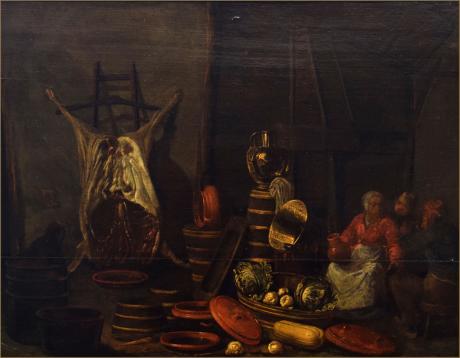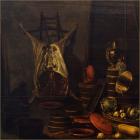signed with monogram lower right on the wall
A game larder, also sometimes known as a deer or venison larder, deer, venison or game house, game pantry or game store, is a small domestic outbuilding where the carcasses of game, including deer, game birds, hares and rabbits, are hung to mature in a cool environment. A feature of large country houses in Britain and parts of northern Europe from the 18th century, game larders continue to be used by shooting estates.
A separate building for storing game during the maturation process improves ventilation, while reducing the odour problem. Most large country houses in Britain had a game larder, and numerous examples built between the early 18th and early 20th centuries survive. The structure also existed in other European countries where hunting or shooting game was popular, including Germany and Austria–Hungary.
Game larders were usually situated near the kitchen.The usual English design is single storey, sometimes octagonal, and usually of brick or stone construction; ventilation is provided by louvred roof lanterns and louvred or mesh-covered unglazed windows.Some game larders had separate rooms for small and large game. A stone or slate floor helped to cool the room. By the early 20th century, refrigeration via cooling pipes was employed. Game larders were sometimes combined with other outbuildings, especially ice houses, as for example atElvaston Castle in Derbyshire and Raith Park in Fife. In central Europe, ice houses were themselves sometimes used for storing deer carcasses. Rails or beams were used to support deer on hooks, with roof-suspended racks, sometimes on pulleys, for small game. Shelves, possibly of marble, were also used. Another necessary fixture described by Victorian architectRobert Kerr is a dresser topped with slate or marble for meat preparation. A relatively early example is the game larder at Farnborough Hall, Warwickshire, which dates from around 1750 and is thought to be by Sanderson Miller; the hexagonal rendered-brick structure has a loggia with Tuscan columns and is surmounted with a wooden cupola. An example of an unornamented square game larder stands at Studley Park in Yorkshire; built in limestone, it dates from the late 18th century.The square stone game larder at Rydal Hall in Cumbria has a timber upper storey reached by an external staircase. Although most extant game larders are built in stone or brick, some timber examples have survived. Examples include the structures at Brodsworth Hall, Yorkshire, Audley End House, Essex, and the Bird Game Larder at Ardverikie House, Badenoch and Strathspey.
Jan Steen, in full Jan Havickszoon Steen (born c. 1626, Leiden, Netherlands—died February 3, 1679, Leiden), Dutch painter of genre, or everyday, scenes, often lively interiors bearing a moralizing theme.
Steen is unique among leading 17th-century Dutch painters for his humour; he has often been compared to the French comic playwrightMolière, his contemporary, and indeed both men treated life as a vast comedy of manners. Some of the artist’s biblical and classical paintings such asAntony and Cleopatra (1667) may have been inspired by the contemporary stage. His portraits of rhetoricians, such asRhetoricians at a Window (1658–65), attest to his interest in these groups of amateur actors.
Steen was enrolled at the University of Leiden in 1646 and in 1648 was one of the founding members, along with Gabriel Metsu and others, of the Leidenpainters’ Guild of St. Luke. His early teachers seem to have been the historical painter Nicolaus Knupfer at Utrecht, genre and landscape painter Adriaen van Ostade at Haarlem, and the landscapist Jan van Goyen at The Hague. In 1649 Steen married van Goyen’s daughter and settled at The Hague for the next few years. He moved toDelft in 1654 and to Haarlem in 1661. In 1670 he was back in Leiden, and in 1673 he married again.
In Steen’s landscapes, including his winter scenes, small earthy figures recall those of Adriaen and ofIsack van Ostade. In his later works the figures are larger, less crowded, and more individually characterized. He shows them playing cards or the bowling game called skittles, or carousing, as inSkittle Players Outside an Inn (c. 1660). His frequent use of inns probably reflects his own background as the son of a brewer and sometime brewer and tavernkeeper himself. He was a master at capturing subtleties of facial expression, especially in children. His best works display great technical skill, particularly in the handling of colour.
During Steen’s last years, his paintings began to anticipate the Rococo style of the 18th century, becoming increasingly elegant and somewhat less energetic, as in the Serenade (c. 1675), and showing a heavy French influence and an increased flamboyance.



